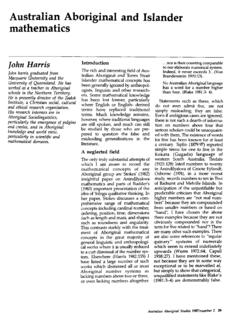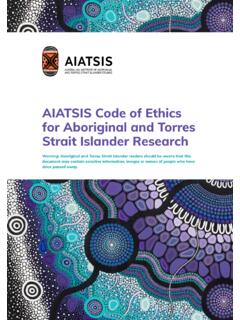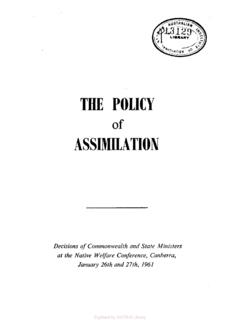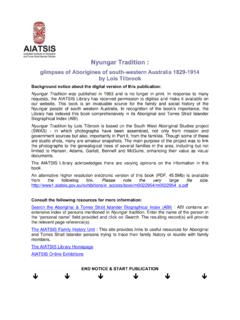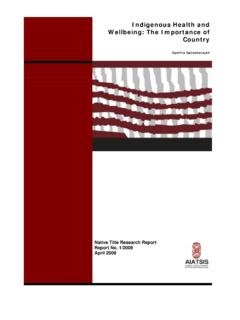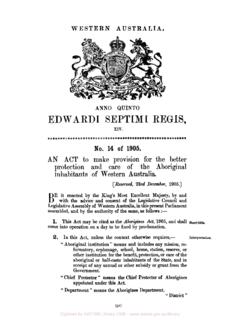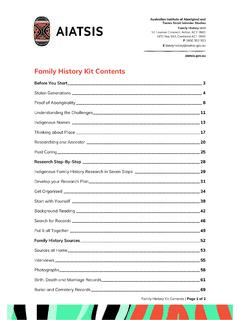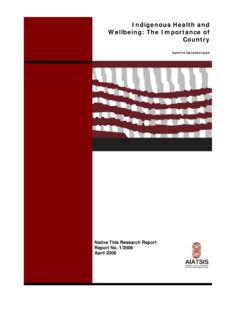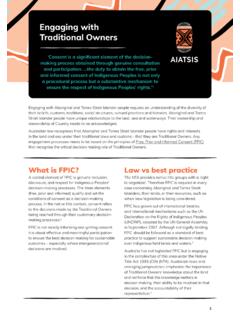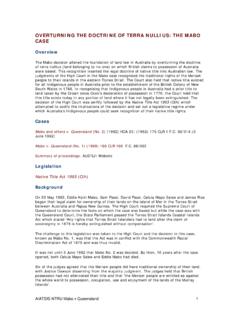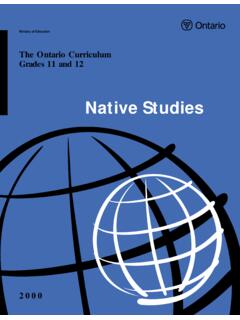Transcription of Teachers’ Notes: Aboriginal Identity (Legends, Country of ...
1 Teachers' notes : Aboriginal Identity (Legends, Country of the Heart, Auntie Rita). Aboriginal Studies Press Please read our copyright information on the following page. Citation: Aboriginal Studies Press 2011, Teachers' notes : Aboriginal Identity (Legends, Country of the Heart, Auntie Rita)', Aboriginal Studies Press, AIATSIS. Teachers' notes : Aboriginal Identity This work is Australian Institute of Aboriginal And Torres Strait Islander Studies (AIATSIS). 2011 and subject to the Copyright Act 1968 (Cth). You may use the material in your organisation, or your teaching, only in an unaltered form. This permission includes downloading, displaying, printing and reproducing the material. You must not do the following without obtaining permission from AIATSIS: charge others for access to the work include the work in advertising or a product for sale host the work or an extract of it on a server or within a website modify the work.
2 Your use of this document does not express or imply an association with AIATSIS. These notes were produced for Aboriginal Studies Press by Jennet Cole-Adams and Judy Gauld (Curriculum Development and Education Consulting). Copies of the book are available from educational suppliers and bookshops or directly from Aboriginal Studies Press. Please visit the Aboriginal Studies Press website at or call us on 02 6246 1183 or email Other teachers' notes available from Aboriginal Studies Press include: The 1967 Referendum Aboriginal Sydney Back on the Block Bangu the Flying Fox The Bittangabee Tribe Cleared Out and Contact Little Red Yellow Black Book + LRYB website Murray River Country Palm Island Singing the Coast Aboriginal Identity : Legends, Country of the Heart and Auntie Rita Indigenous Voices: Thinking Black, The 1967 Referendum, Back on the Block and Doreen Kartinyeri 2.
3 Australian Institute of Aboriginal and Torres Strait Islander Studies (AIATSIS), 2011. Teachers' notes : Aboriginal Identity Aboriginal Identity in Australia: Student activities to support Year 9-10 English in the Australian Curriculum For teachers This learning resource enables Year 9-10 students to explore Aboriginal Identity in Australia through three texts that present strong Aboriginal voices. The learning sequence is aligned to the Australian Curriculum: English, and supports the requirement that: The range of literary texts for Foundation to Year 10 comprises Australian literature, including the oral narrative traditions of Aboriginal and Torres Strait Islander peoples, as well as the contemporary literature of these two cultural groups . This resource allows students to develop several of the general capabilities identified in the Australian Curriculum including literacy; critical and creative thinking; and intercultural understanding.
4 It also relates to the cross curriculum priority Aboriginal and Torres Strait Islander histories and cultures. An exploration of Aboriginal Australian Identity is valuable for all young Australians. Aboriginality plays an important role in the construction of a broader Australian Identity ; the appropriation of Indigenous imagery in film, fashion and advertising attests to this. Identity for most Aboriginal Australians is informed by both the broad Australian culture and their own Aboriginal connections and practices. The history of interactions between Indigenous and non-Indigenous Australians has also impacted profoundly on Aboriginal notions of Identity . Aboriginal Studies Press (ASP) is uniquely placed to provide publications that present an authentic Indigenous voice to explore this theme. Three titles, available from ASP, have been selected to support this learning resource.
5 Legends: The AFL Indigenous Team of the Century, Sean Gorman, Aboriginal Studies Press, 2011. Indigenous Australians have given us some of our greatest football champions. With names like Winmar, Long, Rioli and Goodes, the stories of Indigenous footballers are some of the most compelling in the game of AFL. The journey for some has been one of great struggle and difficulty. For them, football was the only way out. Identity is a central theme in this book of short inspirational biographies that will fully engage your students. Country of the Heart, Aboriginal Studies Press, 2011. Through the wonderful photographic images and the stories of the Mak Mak clan, readers are led into the heart of Country : the people, the animals, the plants, the ancestors, the seasons and the 3. Australian Institute of Aboriginal and Torres Strait Islander Studies (AIATSIS), 2011.
6 Teachers' notes : Aboriginal Identity intimate relationships which tie them together. For the Mak Mak people, whose homelands are south west of Darwin, Identity and Country are inextricably linked. Auntie Rita, Aboriginal Studies Press, 1994 (reprinted 2010). This book explores the life of Rita Huggins, beginning with her family being stolen from her born Country ' and taken to a mission. Told through the perceptive, witty and honest voices of both Rita Huggins and her daughter Jackie, this title explores the richness and challenges of Rita's life as an Aboriginal Australian. The learning resource supports each of these titles with a sequence of learning activities: Shaping Identity activities focus on the formation and portrayal of Identity Shaping text activities explore how structure and language create meanings within texts Shaping your self activities ask students to create texts which explore aspects of their own identities.
7 The relevant Australian Curriculum: English content descriptions for Years 9 and 10 for these learning activities are outlined below. Language Literature Literacy Year 9 Year 9 Year 9. - Understand that roles and - Interpret and compare how - Analyse how the construction and relationships are developed and representations of people and culture interpretation of texts, including challenged through language and in literary texts are drawn from media texts, can be influenced by interpersonal skills. different historical, social and cultural cultural perspectives and other texts. - Understand that authors innovate contexts. - Interpret, analyse and evaluate how with text structures and language for - Explore and reflect on personal different perspectives of issue, event, specific purposes and effects. understanding of the world and situation, individuals or groups are - Analyse and explain the use of significant human experience gained constructed to serve specific purposes symbols, icons and myth in still and from interpreting various in texts.
8 Moving images and how these representations of life matters in texts. - Use comprehension strategies to augment meaning. - Analyse texts from familiar and interpret and analyse texts, comparing - Identify how vocabulary choices unfamiliar contexts, and discuss and and evaluating representations of an contribute to specificity, abstraction evaluate their content and the appeal event, issue, situation or character in and stylistic effectiveness. of an individual author's literary style. different texts. - Analyse text structures and language - Explore and explain the combinations Year 10 features of literary texts, and make of language and visual choices that - Understand how language use can relevant comparisons with other texts. authors make to present information, have inclusive and exclusive social - Create literary texts, including hybrid opinions and perspectives in different effects, and can empower or texts, that innovate on aspects of texts.
9 Disempower people. other texts, for example by using - Create imaginative, informative and - Understand that people's evaluations parody, allusion and appropriation. persuasive texts that present a point of texts are influenced by their value of view and advance or illustrate systems, the context and the purpose arguments, including texts that Year 10. and mode of communication. integrate visual, print and/or audio - Analyse and explain how text - Compare the purposes, text features. structures, language features and structures and language features of visual features of texts and the context traditional and contemporary texts in in which texts are experienced may Year 10. different media. influence audience response. - Analyse and evaluate how people, - Evaluate the impact on audiences of - Identify, explain and discuss how cultures, places, events, objects and different choices in the representation narrative viewpoint, structure, concepts are represented in texts, of still and moving images.
10 Characterisation and devices including including media texts, through 4. Australian Institute of Aboriginal and Torres Strait Islander Studies (AIATSIS), 2011. Teachers' notes : Aboriginal Identity analogy and satire shape different language, structural and/or visual interpretations and responses to a text choices. - Create literary texts with a sustained - Identify and explore the purposes voice', selecting and adapting and effects of different text structures appropriate text structures, literary and language features of spoken texts, devices, language, auditory and visual and use this knowledge to create structures and features for a specific purposeful texts that inform, persuade purpose and intended audience. and engage. - Identify and analyse implicit or explicit values, beliefs and assumptions in texts and how these are influenced by purposes and likely audiences.
